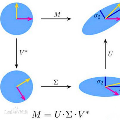A CUR factorization is often utilized as a substitute for the singular value decomposition (SVD), especially when a concrete interpretation of the singular vectors is challenging. Moreover, if the original data matrix possesses properties like nonnegativity and sparsity, a CUR decomposition can better preserve them compared to the SVD. An essential aspect of this approach is the methodology used for selecting a subset of columns and rows from the original matrix. This study investigates the effectiveness of \emph{one-round sampling} and iterative subselection techniques and introduces new iterative subselection strategies based on iterative SVDs. One provably appropriate technique for index selection in constructing a CUR factorization is the discrete empirical interpolation method (DEIM). Our contribution aims to improve the approximation quality of the DEIM scheme by iteratively invoking it in several rounds, in the sense that we select subsequent columns and rows based on the previously selected ones. That is, we modify $A$ after each iteration by removing the information that has been captured by the previously selected columns and rows. We also discuss how iterative procedures for computing a few singular vectors of large data matrices can be integrated with the new iterative subselection strategies. We present the results of numerical experiments, providing a comparison of one-round sampling and iterative subselection techniques, and demonstrating the improved approximation quality associated with using the latter.
翻译:暂无翻译



